Auditplanung/en: Unterschied zwischen den Versionen
Weitere Optionen
Faha (Diskussion | Beiträge) Keine Bearbeitungszusammenfassung |
Isan (Diskussion | Beiträge) Keine Bearbeitungszusammenfassung |
||
| (67 dazwischenliegende Versionen von 4 Benutzern werden nicht angezeigt) | |||
| Zeile 1: | Zeile 1: | ||
__FORCETOC__ | __FORCETOC__ | ||
<span id="audits"></span> | <span id="audits"></span> | ||
In the course of risk or quality management and other areas of business, it is common to schedule audits to which reviews or analyses are assigned. Usually, audits, e.g. "First audit of clinic Y" or "Update of all BIAs 2022" are planned over several days or weeks. They can be bundled into audit programs. Several individual audits and their reviews (e.g., business impact analyses, risk analyses, re-audits of findings, etc.) are then conducted for the audit programs with different people from the organizational unit to be audited. | In the course of risk or quality management and other areas of business, it is common to schedule audits to which reviews or analyses are assigned. Usually, audits, e.g. "First audit of clinic Y" or "Update of all BIAs 2022" are planned over several days or weeks. They can be bundled into audit programs. Several individual audits and their reviews (e.g., business impact analyses, risk analyses, re-audits of findings, etc.) are then conducted for the audit programs with different people from the organizational unit to be audited. | ||
Experts and professionals can create and manage audits and audit programs under "Audit Management → Audit planning". | Experts and professionals can create and manage audits and audit programs under "Audit Management → Audit planning". | ||
== <span id="Audits"></span>Audits == | == <span id="Audits"></span>Audits == | ||
In the "Audit management → Audit planning → | In the "Audit management → Audit planning → <u>Audits</u> | Audit programs" overview, all audits and blockers that exist in the currently selected management system are listed.<br> | ||
Using the pink button, audit reports can be downloaded as PDF or Word files.<br> | Using the pink button, audit reports can be downloaded as PDF or Word files.<br> | ||
New audits can be created with the plus button.<br> | New audits or blockers can be created with the plus button.<br> | ||
[[Datei:AM Audit Übersicht.png|left|thumb|901px|Audit overview]]<br clear=all> | [[Datei:AM Audit Übersicht.png|left|thumb|901px|Audit overview]]<br clear=all> | ||
<u> Information about the columns State audit plan report/audit report/audit program report</u>: | |||
These columns show whether the respective report has already been generated with revision information in the report archive and what recipients it was sent to. The first line shows the revision state and number. Below that is a list of the recipients of the most recent version of the report, or the information, when the report was last sent to the full recipient pool. The information revision state, revision number, and sent to correspond with the information entered in the dialog when choosing "generate with revision information in archive". | |||
Regarding the order of entries: entries are first sorted descending by version number (newest/highest first). If the same version number is used multiple times, entries are also sorted by the report creation date (latest generated report is displayed). | |||
===Assessment of audit times in the overview=== | |||
The duration in days and hours can be displayed and summed up for audits. For this, the two columns "Audit days" and "Audit hours" are displayed in the overviews under Audit management > Audit planning > Audits as well as Audit management > Audit planning > Edit audit program > Assigned audits. | |||
An audit day is any day that has at least one review scheduled (these reviews do not have to be completed to count, they can just be planned as well). On an audit day, the hours of the reviews are counted as audit ours. Other appointments are not counted into neither audit days nor audit hours. Blockers, too, do not factor into these sums. | |||
The filter options in the two overview grids allow for the summing up of the audit times by varying characteristics. For example, external audit days or the hours of a specific lead-auditor can be assessed. | |||
Example: If a three-hour review is done on one day and a two-hour one on another day for Audit A, then it is an audit with 2 days and 5 hours, respectively. Were these reviews planned for the same day, it would be 1 day and 5 hours, respectively. | |||
[[Datei:Auditzeiten.png|left|thumb|901px|Audit times]]<br clear=all> | |||
=== Create/edit/delete audit === | === Create/edit/delete audit === | ||
To create an audit you have to click on the "plus" button in the overview. | To create an audit you have to click on the "plus" button in the overview. | ||
If you want to delete or edit an audit, e.g. because the status has changed, | If you want to delete or edit an audit, e.g. because the status has changed, double-click the desired audit in the overview. | ||
You can also schedule new reviews here or assign existing reviews to the audit. (see [[Special:MyLanguage/Audit erstellen#Zugeordnete Überprüfungen|assigned reviews]]). | You can also schedule new reviews here or assign existing reviews to the audit. (see [[Special:MyLanguage/Audit erstellen#Zugeordnete Überprüfungen|assigned reviews]]). | ||
| Zeile 24: | Zeile 40: | ||
<b>Hint:</b> For details on the master data of an audit and the assigned reviews, see <b>[[Special:MyLanguage/Audit erstellen|Create audit]]</b>. | <b>Hint:</b> For details on the master data of an audit and the assigned reviews, see <b>[[Special:MyLanguage/Audit erstellen|Create audit]]</b>. | ||
[[Datei:Audit erstellen 2.PNG|left|thumb| | [[Datei:Audit erstellen 2.PNG|left|thumb|905px|Editing a audit]]<br clear=all> | ||
<span id="Status_und_Workflow_von_Audits"></span> | |||
===<span id="audit_workflow"></span> Audit status and workflow === | ===<span id="audit_workflow"></span> Audit status and workflow === | ||
This graphic describes how the workflow button affects the status of the audit: | |||
[[Datei:Audit-Workflow.png| | [[Datei:Audit-Workflow.png|right|thumb|700px|Workflow and state transitions]] | ||
After an audit is created, it is in the "Draft" status. This status is additionally marked as "delayed" if the current date is later than the start date of the audit. | After an audit is created, it is in the "Draft" status. This status is additionally marked as "delayed" if the current date is later than the start date of the audit. | ||
Only when the audit is released by the workflow button with the option "Release planning", it changes to the next status. The next status is either "Planned", "In progress" or "In rework". This status depends on the date of the audit and is changed automatically: | Only when the audit is released by the workflow button with the option "Release planning", it changes to the next status. The next status is either "Planned", "In progress" or "In rework". This status depends on the date of the audit and is changed automatically: | ||
* Planned | * Planned: The audit is released and the current date is earlier than the audit start date. | ||
* In progress: Audit is released and the current date is between the audit start date and audit end date. | |||
* In progress | * In rework: The audit is released and the current date later than the audit end date. | ||
* In rework | |||
During this status, the workflow button shows the option "Complete report". Clicking this closes the audit. The audit can also be closed automatically, as after the last open review is completed, the auditor will be asked if the audit should be closed. | During this status, the workflow button shows the option "Complete report". Clicking this closes the audit. The audit can also be closed automatically, as after the last open review is completed, the auditor will be asked if the audit should be closed. | ||
Additionally, the workflow button can be expanded to return the audit to draft status or cancel it in general. | Additionally, the workflow button can be expanded to return the audit to draft status or cancel it in general. | ||
* Edit plan | * Edit plan: Audit changes back into "Draft" state. | ||
* Cancel audit planning/Cancel audit: Sets the audit to the state canceled. | |||
* Cancel audit planning/Cancel audit | |||
===Measures & controls=== | |||
This overview shows all measures and controls that are linked with the audit, e.g., via the gaps identified in an analysis. | |||
<span id="Terminkalender_anchor"></span> | |||
[[Datei:Terminkalender Agenda.png|right|thumb|500px|Agenda]] | |||
<span id="Terminkalender"></span> | |||
=== Appointment calendar === | === Appointment calendar === | ||
In the calendar, audit dates such as the start of an audit can be viewed or other dates that occur in the course of an audit, such as breaks or kick-off meetings, can be recorded. | In the calendar, audit dates such as the start of an audit can be viewed or other dates that occur in the course of an audit, such as breaks or kick-off meetings, can be recorded. | ||
The calendar within the audit shows the first appointment in the audit when opened. | The calendar within the audit shows the first appointment in the audit when opened. | ||
If there are no appointment entries within the audit yet, the start date of the audit is displayed. | If there are no appointment entries within the audit yet, the start date of the audit is displayed. | ||
The reviews are displayed in the color that is stored in the audit | The reviews and other appointments are displayed in the color that is stored in the audit. | ||
In the calendar, the displayed period can be set in the upper left corner. With the dropdown on the top right you can switch between month, week, day and agenda display. | In the calendar, the displayed period can be set in the upper left corner. With the dropdown on the top right you can switch between month, week, day and agenda display. | ||
In the Agenda tab, you can find all the dates of the audit of the selected week. | |||
[[Datei:Audit Termin.PNG|left|thumb|900px|Appointment calendar]]<br clear=all> | |||
<br clear=all> | |||
[[Datei:Kalender Überprüfung TT.png|rechts|thumb|401px|Appointment details]] | |||
By simply clicking on a review, information about the review is displayed. By clicking on the edit button (pencil within the three dots on the top right), the respective review opens. | |||
In the appointment schedule, appointments/reviews can also be created as described in [[#appointment|Create appointment]]. However, this is only possible as long as the audit has not been closed. | In the appointment schedule, appointments/reviews can also be created as described in [[#appointment|Create appointment]]. However, this is only possible as long as the audit has not been closed.<br clear=all> | ||
<span id="Management_Summary"></span> | |||
=== <span id="mms"/> Management Summary === | === <span id="mms"/> Management Summary === | ||
| Zeile 84: | Zeile 100: | ||
[[Datei:Audit Management Summary.PNG|left|thumb|900px|Management Summary]]<br clear=all> | [[Datei:Audit Management Summary.PNG|left|thumb|900px|Management Summary]]<br clear=all> | ||
<span id="Auditprogramme"></span> | |||
== <span id="Audit programs"></span>Audit programs == | == <span id="Audit programs"></span>Audit programs == | ||
| Zeile 99: | Zeile 116: | ||
If you delete an audit program, the assigned audits are '''not''' deleted. They still exist and can be assigned to other audit programs. | If you delete an audit program, the assigned audits are '''not''' deleted. They still exist and can be assigned to other audit programs. | ||
[[Datei:Auditprogramm erstellen 2.PNG|left|thumb| | [[Datei:Auditprogramm erstellen 2.PNG|left|thumb|902px]]<br clear=all> | ||
<span id="Status_und_Workflow_von_Auditprogrammen"></span> | |||
===<span id="auditprog_workflow"></span> Status and workflow of audit programs === | ===<span id="auditprog_workflow"></span> Status and workflow of audit programs === | ||
This graphic describes how the Workflow button affects the status of the audit program: | |||
[[Datei:Auditprogramm workflow.png| | [[Datei:Auditprogramm workflow.png|right|thumb|700px|Workflow and state transitions]] | ||
After an audit program is created, it is in "Draft" status. | After an audit program is created, it is in "Draft" status. | ||
Only when the audit program is released by the workflow button with the option "Release planning", it changes to the next status. The next status is either "Planned" or "In progress". This status depends on the date of the audit and is changed automatically: | Only when the audit program is released by the workflow button with the option "Release planning", it changes to the next status. The next status is either "Planned" or "In progress". This status depends on the date of the audit and is changed automatically: | ||
* Planned | * Planned: The audit program is released and the current date is earlier than the audit start date. | ||
* In progress: The audit program is released and the current date is between the audit start date and audit end date. | |||
* In progress | |||
In this status, the workflow button shows the option "Complete audit program". Clicking this closes the audit program. The audit program can also be closed automatically, since after the last open audit is completed, the auditor is asked whether the audit program should be closed. | In this status, the workflow button shows the option "Complete audit program". Clicking this closes the audit program. The audit program can also be closed automatically, since after the last open audit is completed, the auditor is asked whether the audit program should be closed. | ||
| Zeile 120: | Zeile 135: | ||
In addition, the workflow button can be expanded to return the audit program into the "Draft" status. | In addition, the workflow button can be expanded to return the audit program into the "Draft" status. | ||
=== <span id="Terminkalender"></span>Audit calendar=== | <span id="Auditkalender"></span> | ||
=== <span id="Terminkalender"></span> Audit calendar=== | |||
In the calendar, the dates of the audits of the audit program can be viewed. In the "Month" view, all audits that start, end or run in this month are displayed. In the "Agenda" view, it is possible to view what is planned for the week on a weekly basis. The view can be changed using the dropdown at the top right of the search field. | In the calendar, the dates of the audits of the audit program can be viewed. In the "Month" view, all audits that start, end or run in this month are displayed. In the "Agenda" view, it is possible to view what is planned for the week on a weekly basis. The view can be changed using the dropdown at the top right of the search field. | ||
| Zeile 133: | Zeile 149: | ||
[[Datei:Auditprogramm Auditkalender.png|left|thumb|903px|Audit program calendar]]<br clear=all> | [[Datei:Auditprogramm Auditkalender.png|left|thumb|903px|Audit program calendar]]<br clear=all> | ||
[[Datei:Kalender Überprüfung TT.png|right|thumb|400px|Appointment details]] | |||
By simply clicking on an audit/review, additional information will be displayed. By clicking on the edit button (pencil within the three dots on the top right), the respective audit/review opens. | |||
You can also carry out general/detailed planning in this calendar | You can also carry out general/detailed planning (planning of blockers and conversion of blockiers into audits) in this calendar. | ||
Furthermore, as described in [[#appointment|Create appointment]], appointments/reviews can also be created. | Furthermore, as described in [[#appointment|Create appointment]], appointments/reviews can also be created. | ||
However, appointments can only be created as long as the audit program is not closed. | However, appointments can only be created as long as the audit program is not closed.<br clear=all> | ||
==Audit planner= | |||
[[Datei:Auditplaner_Buttons.png|right|thumb|200px|Planerbutton]]Out of the audit program, the audit, and the corresponding overviews, it's possible to navigate to a planning view at the click of a button that offers these possibilities: | |||
*edit master data (name, start and end date; for audits and assessments also the OU and the lead auditor) | |||
*add audits to an audit program or remove them | |||
*add assessments to an audit or remove them | |||
*navigate to the audit program, an audit, or an assessment with one click | |||
*add topics from knowledge bases and/or topic collections with drag & drop (find more on topic collections [[Special:MyLanguage/Auditmanagement_Einstellungen#Themensammlungen|here]]) | |||
[[Datei:Auditplaner_AP.png|left|thumb|901px|Auditplaner]]<br clear=all> | |||
Vertical scrolling moves you from one audit to another within the audit program.<br> | |||
Horizontal scrolling moves you from one assessment to another within an audit.<p> | |||
New elements (audits and assessments) can be added with the various "plus" buttons. The "trash can" buttons serve to delete elements (audits and assessments) that haven't been closed yet. The "link" buttons take users to the respective elements. | |||
===Planner - audit program=== | |||
Opening the planner from an audit program or from the overview of audit programs, takes you to an interface where you can access all audits of the program. You can edit or delete these, or create further audits. Within the audit, reviews can be created, edited, or deleted. Closed reviews, audits, and audit programs, however, are not editable. | |||
===Planner - audit=== | |||
Opening the planner from an audit or from the overview of audits, takes you to an interface where you can also see the audit program. However, it only includes the selected audit, within which you are positioned in order to work there.<p>From the audit planner you can navigate to the audit program planner. | |||
===Adding review objects to reviews=== | |||
In the audit planner you can select topic collections and knowledge bases, and receive a list of all topics contained therein. These can be added to reviews via drag & drop. When adding them, the list view shows how many times a topic has been added to reviews of the shown audits. [[Datei:TS_AuditHinzufügen.png|left|thumb|900px|Auditplaner]]<br clear=all> | |||
This makes it possible to edit all reviews of all audits of an audit program in one single view and to either split up larger topic collections among them or to assign smaller topic collections to one, more or all reviews. Topic collections and knowledge bases can be mixed when doing this. | |||
===Revaluation via the audit planner== | |||
[[Datei:Auditplaner_Themensammlung_NeubewertungIcon.png|thumb|500px|right|Revaluation available]] In the audit planner, an exclamation point shows if there is already a closed review for a topic from a knowledge base or a topic collection.<p>It is possible to create a revaluation instead of a further first-time evaluation for this topic. Just like in the review assistant under [[Special:MyLanguage/Überprüfung#Neubewertung_bestehender_Prüfobjekte|revaluation of existing review objects]], you have the option to choose whether you would like to take over all/none/positive answers and whether you would like to pre-fill in a justification for all answers.<br clear=all> | |||
[[Datei:Auditplaner_Überprüfung_NeubewertungIcon.png|right|thumb|400px|Button in the review]] In the review itself, these topic/review objects have an "exclamation point" button which opens the dialog and allows the options to be edited.<br clear=all> | |||
[[Datei:Auditplaner_ZurNeubewertungVerfügbarePrüfobjekte.png|right|thumb|500px|Zur Neuobewertung verfügbare Prüfobjekte]] A further option the audit planner offers is the collected revaluation of different review objects, which can be viewed all together within the list item "Objects of review available for reassessment". From this overview you can then select all review objects you would like to revaluate. Here, too, you have the option to choose whether you would like to take over all/none/positive answers and whether you would like to pre-fill in a justification for all answers. | |||
== <span id="audit_calender"></span> | <!-- | ||
== <span id="audit_calender"></span> Overall audit calendar == | |||
On the page "Audit management → Audit planning → <u> Audit calendar</u> | Audits | Audit programs", a calendar is displayed providing information on <b>all</b> audits. Thus, all audits from all audit programs are displayed. | On the page "Audit management → Audit planning → <u> Audit calendar</u> | Audits | Audit programs", a calendar is displayed providing information on <b>all</b> audits. Thus, all audits from all audit programs are displayed. | ||
The radio buttons | The radio buttons to the left can be used to switch between showing audits and audit appointments. The checkboxes can be used to select which types of appointments are displayed in the calendar. | ||
The audits/audit appointments are displayed in the color that has been set in the audit. | The audits/audit appointments are displayed in the color that has been set in the audit. | ||
| Zeile 155: | Zeile 200: | ||
The "Today" button, depending on the selected period, either shows the day view or highlights the day (week views). | The "Today" button, depending on the selected period, either shows the day view or highlights the day (week views). | ||
Double-clicking on an audit or audit appointment opens the detail page of the audit | Double-clicking on an audit or audit appointment opens the detail page of the audit or the review for the audit appointment, respectively. | ||
[[Datei:Auditkalender.png|left|thumb| | [[Datei:Auditkalender.png|left|thumb|907px|Audit calendar]]<br clear=all> | ||
[[Datei:AM | [[Datei:AM Kalender Sucher Ergebnis.png|right|thumb|500px|Search]] | ||
<span id="Suche"></span> | |||
=== Search === | === Search === | ||
The search field can be used to search for specific audits or audit appointments. | The search field can be used to search for specific audits or audit appointments. | ||
All | All results of the search are displayed in a list. Double-clicking on a result opens the appointment. | ||
Additionally, the search can be refined by setting filters. It is possible to filter by audit programs and audits, auditors and co-auditors, as well as by organizational unit. For the organizational units, additional information is also available, such as audit cluster and type. | Additionally, the search can be refined by setting filters. It is possible to filter by audit programs and audits, auditors and co-auditors, as well as by organizational unit. For the organizational units, additional information is also available, such as audit cluster and type. | ||
<span id="Status_von_Audits_und_Auditterminen"></span> | |||
=== Status of audits and audit appointments === | === Status of audits and audit appointments === | ||
In the calendar, audits and audit appointments are labelled based on their status: | In the calendar, audits and audit appointments are labelled based on their status: | ||
{| class="wikitable" | |||
!Element | |||
!State | |||
|- | |||
!Reviews<br>''(3 circles)'' | |||
|Draft (1/3)<br>In process (2/3)<br>Closed (3/3) | |||
|- | |||
!Self assessment reviews<br>''(4 circles)'' | |||
|Draft (1/4)<br>In process (1/4)<br>Requested (2/4)<br>Answered (3/4)<br>Closed (4/4) | |||
|- | |||
!Audits<br>''(5 circles)'' | |||
|Draft (1/5)<br>Draft (delayed) (1/5, orange)<br>Planned (2/5)<br>In progress (3/5)<br>In rework (4/5)<br>Closed (5/5)<br>Measure processing (5/5)<br>Cancelled (5/5, red) | |||
|} | |||
[[Datei:AM Kalender HoverTT.png|right|thumb|400px|Appointment details]] | |||
In addition, an audit/appointment may be marked with a triangle containing a exclamation mark. This can have the following causes: | In addition, an audit/appointment may be marked with a triangle containing a exclamation mark. This can have the following causes: | ||
| Zeile 205: | Zeile 242: | ||
Clicking once on an audit/audit appointment will display additional information. Clicking on the edit button (pencil on the top right) opens the respective audit or audit appointment. If the audit or appointment is marked with a triangle containing a exclamation mark, the reason for it can be also be found here. | Clicking once on an audit/audit appointment will display additional information. Clicking on the edit button (pencil on the top right) opens the respective audit or audit appointment. If the audit or appointment is marked with a triangle containing a exclamation mark, the reason for it can be also be found here. | ||
[[Datei:AM | <br clear=all> | ||
[[Datei:AM AK Grobplannung.png|right|thumb|500px|Create blocker]] | |||
=== <span id="grobfein"></span> | <span id="Blocker_und_Audits_erstellen"></span> | ||
=== <span id="grobfein"></span> Create blockers and audits === | |||
To get the planning options, the view must be set to "Audits" and not "Audit appointments". | To get the planning options, the view must be set to "Audits" and not "Audit appointments". | ||
In an optional first step, blockers can be created. This can be used to keep appointments free if more detailed information about the audit is not yet available. Once more precise details about the audit are known, a blocker can be converted into an audit. | |||
To create a "blocker", right-click into an empty area and click on the option "Create blocker". | |||
An area can be selected and turned into a so-called "blocker" with a right-click. The borders of the selected area are used as the start and end date. | |||
If the blocker is assigned to an audit program, it can be pre-filled with some of the audit program's basic data (start and end date, partisanship). When creating an appointment in the calendar, the already selected date is not overwritten. To pre-fill information, simply click the button next to the audit program. | |||
<br clear=all> | |||
[[Datei:AM AK | [[Datei:AM AK Feinplannung.png|right|thumb|500px|Create audit]] | ||
The conversion to an audit in the second step is used to fix blockers and thus create audits. | |||
To perform | To perform this conversion, right-click on a "blocker" and click on the option "Convert to audit" or double-click into an empty area (left-click). | ||
If the planned audit is assigned to an audit program, it can be pre-filled with some of the basic data of the audit program (start and end date, organizational unit, partisanship, focuses). When creating an appointment in the calendar, the already selected date is not overwritten. To pre-fill information, simply click the button next to the audit program. | |||
The selection of the organizational unit for the audit can be filtered according to the following criteria in addition to the table: | The selection of the organizational unit for the audit can be filtered according to the following criteria in addition to the table: | ||
* OrgUnit not audited in the last x years. | * OrgUnit not audited in the last x years. | ||
** The x can be set as required. Thereby all OrgUnits that have been audited in the last x years will be displayed grayed out. | ** The x can be set as required. Thereby all OrgUnits that have been audited in the last x years will be displayed grayed out. | ||
* Suggestion to audit this OrgUnit in every audit program. | * Suggestion to audit this OrgUnit in every audit program. | ||
** In | ** In the audit creation, this organizational unit is always suggested for audits if it has not yet been scheduled in the respective audit program. | ||
</ | <u>Note</u>: The option to suggest an OrgUnit for every audit program trumps the restriction of showing only OrgUnits that were not audited in a specific period of time. This means that OrgUnits that are to be suggested for every audit program are not grayed out, no matter when they were last audited. | ||
If an OrgUnit is displayed in italics, then it is no longer active. More about this can be found at [[SSpecial:MyLanguage/OrgEh_-_Organisationseinheiten#orgcre| Organizational Units]].<br clear=all> | |||
[[Datei:TerminartAuswahl2.png|right|thumb|700px|Select appointment type via right-click or in the window]] | |||
=== <span id="appointment"></span> Create audit appointments === | |||
When the view is set to "Audit appointments" and not "Audits", assessments and other appointments can be created in the calendar.<br clear=all> | |||
[[Datei:AM Audit Termin erstellen.png|right|thumb|501px|Create other appointment]] | |||
An assessment or an other appointment for the audit can be created with a right-click onto an empty field in the calendar. It is also possible to select an area and turn this into an assessment or other appointment with a right click. In this case, the margins of the selected area are used for the beginning and end date.<br> | |||
Other appointments are used to plan things such as trips to and from the audit location, or kick-off workshops and the like, in the calendar. The appointments must be assigned to an audit, but otherwise contain less information than assessments. </p><b>Important:</b> The subject and description of the appointment are included in the agenda of the audit report! | |||
<br clear=all> | |||
[[Datei:AM Audit Überprüfung erstellen.png|right|thumb|501px|Create assessment]] | |||
Planned assessments must be assigned to an audit and can then be pre-filled with some of the basic data of the audit (start and end date, organizational unit, lead auditor, co-auditors/companions, responsible). When creating an appointment in the calendar, the already selected date is not overwritten. To pre-fill information, simply click the button next to the audit program. | |||
The appointment type lets you choose whether what you are creating is a protection needs analysis (PNA), a gap analysis (GA), or a review result (RR). If this selection was already made in the calendar, it is not offered again in the window.</p><b>Note:</b> Reviews that have not been assigned to an audit are displayed in the calendar if the respective checkbox "Assessments without audit" is selected. They are shown without color. | |||
<br clear=all> | |||
[[Datei:IcsExport.png|right|thumb|600px|Export calendar item]] | |||
<span id="Export_von_Terminen_und_Besprechungen"></span> | |||
=== <span id="icsexport"></span> Export of appointments and meetings === | |||
Entries from all of the calendars in the audit management module (direclty in audit planning, within the audit, and within the audit program) can be downloaded via the three dots in the tooltip. The respective button downloads an .ics file that can be opened with a double click. | |||
If a calendar entry is downloaded as an appointment, this contains the name as the title, the begin and end time, the location (if an organizational unit has been recorded), as well as the description. The appointment can be saved in the calendar and distributed to others from there. If a calendar entry is downloaded as a meeting, in addition, it contains the participants, provided that an e-mail address has been recorded for the respective users and/or external auditors. The meeting can be saved in the calendar and distributed to the pre-filled participants. | |||
<br clear=all> | |||
The following information is exported with the .ics for each type of entry, provided it has been entered: | |||
[[ | {| class="wikitable" | ||
!Element | |||
!Content in the .ics | |||
|- | |||
!'''Audit''' | |||
|Title: Name + [external] + / Division<br>Time: Begin and end date incl time<br>Location: OrgUnit or adress<br>Text body: Description + Focuses + Remarks | |||
|- | |||
!'''Blocker''' | |||
|Title: [BLOCKER] + Name + [external]<br>Time: Begin and end date incl time<br>Text body: Description | |||
|- | |||
!'''Review''' | |||
|Title: Name + / Function<br>Time: Begin and end date incl time<br>Location: OrgUnit or adress<br>Text body: Description + Remarks | |||
|- | |||
!'''Other appointment''' | |||
|Title: Name<br>Time: Begin and end date incl time<br>Text body: Description | |||
|} | |||
By right-clicking on an empty field, a review for the audit can be created | By right-clicking on an empty field, a review for the audit can be created within the calendar. | ||
An area can be selected and turned into an assessment with a right-click. The borders of the selected area are used as the start and end date. | |||
--> | |||
Aktuelle Version vom 26. November 2024, 11:41 Uhr
In the course of risk or quality management and other areas of business, it is common to schedule audits to which reviews or analyses are assigned. Usually, audits, e.g. "First audit of clinic Y" or "Update of all BIAs 2022" are planned over several days or weeks. They can be bundled into audit programs. Several individual audits and their reviews (e.g., business impact analyses, risk analyses, re-audits of findings, etc.) are then conducted for the audit programs with different people from the organizational unit to be audited.
Experts and professionals can create and manage audits and audit programs under "Audit Management → Audit planning".
Audits
In the "Audit management → Audit planning → Audits | Audit programs" overview, all audits and blockers that exist in the currently selected management system are listed.
Using the pink button, audit reports can be downloaded as PDF or Word files.
New audits or blockers can be created with the plus button.
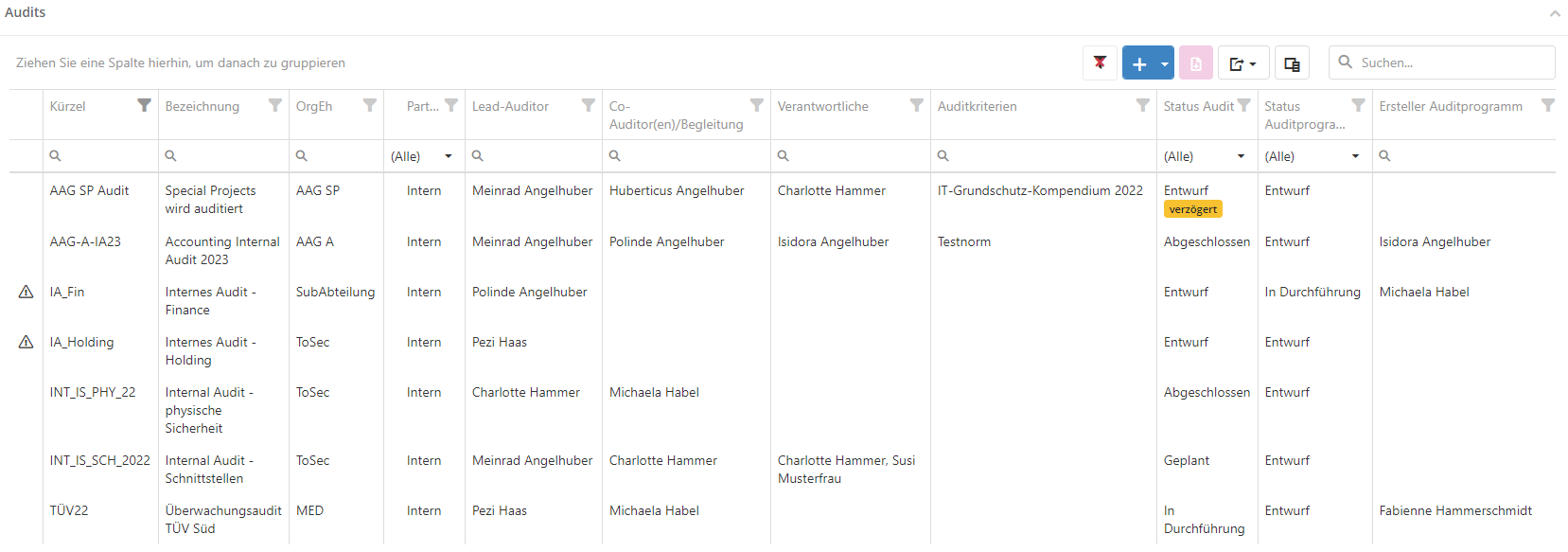
Information about the columns State audit plan report/audit report/audit program report:
These columns show whether the respective report has already been generated with revision information in the report archive and what recipients it was sent to. The first line shows the revision state and number. Below that is a list of the recipients of the most recent version of the report, or the information, when the report was last sent to the full recipient pool. The information revision state, revision number, and sent to correspond with the information entered in the dialog when choosing "generate with revision information in archive".
Regarding the order of entries: entries are first sorted descending by version number (newest/highest first). If the same version number is used multiple times, entries are also sorted by the report creation date (latest generated report is displayed).
Assessment of audit times in the overview
The duration in days and hours can be displayed and summed up for audits. For this, the two columns "Audit days" and "Audit hours" are displayed in the overviews under Audit management > Audit planning > Audits as well as Audit management > Audit planning > Edit audit program > Assigned audits.
An audit day is any day that has at least one review scheduled (these reviews do not have to be completed to count, they can just be planned as well). On an audit day, the hours of the reviews are counted as audit ours. Other appointments are not counted into neither audit days nor audit hours. Blockers, too, do not factor into these sums.
The filter options in the two overview grids allow for the summing up of the audit times by varying characteristics. For example, external audit days or the hours of a specific lead-auditor can be assessed.
Example: If a three-hour review is done on one day and a two-hour one on another day for Audit A, then it is an audit with 2 days and 5 hours, respectively. Were these reviews planned for the same day, it would be 1 day and 5 hours, respectively.

Create/edit/delete audit
To create an audit you have to click on the "plus" button in the overview. If you want to delete or edit an audit, e.g. because the status has changed, double-click the desired audit in the overview.
You can also schedule new reviews here or assign existing reviews to the audit. (see assigned reviews).
If you delete an audit, the assigned reviews are not deleted. They still exist and can be assigned to other audits.
Hint: For details on the master data of an audit and the assigned reviews, see Create audit.
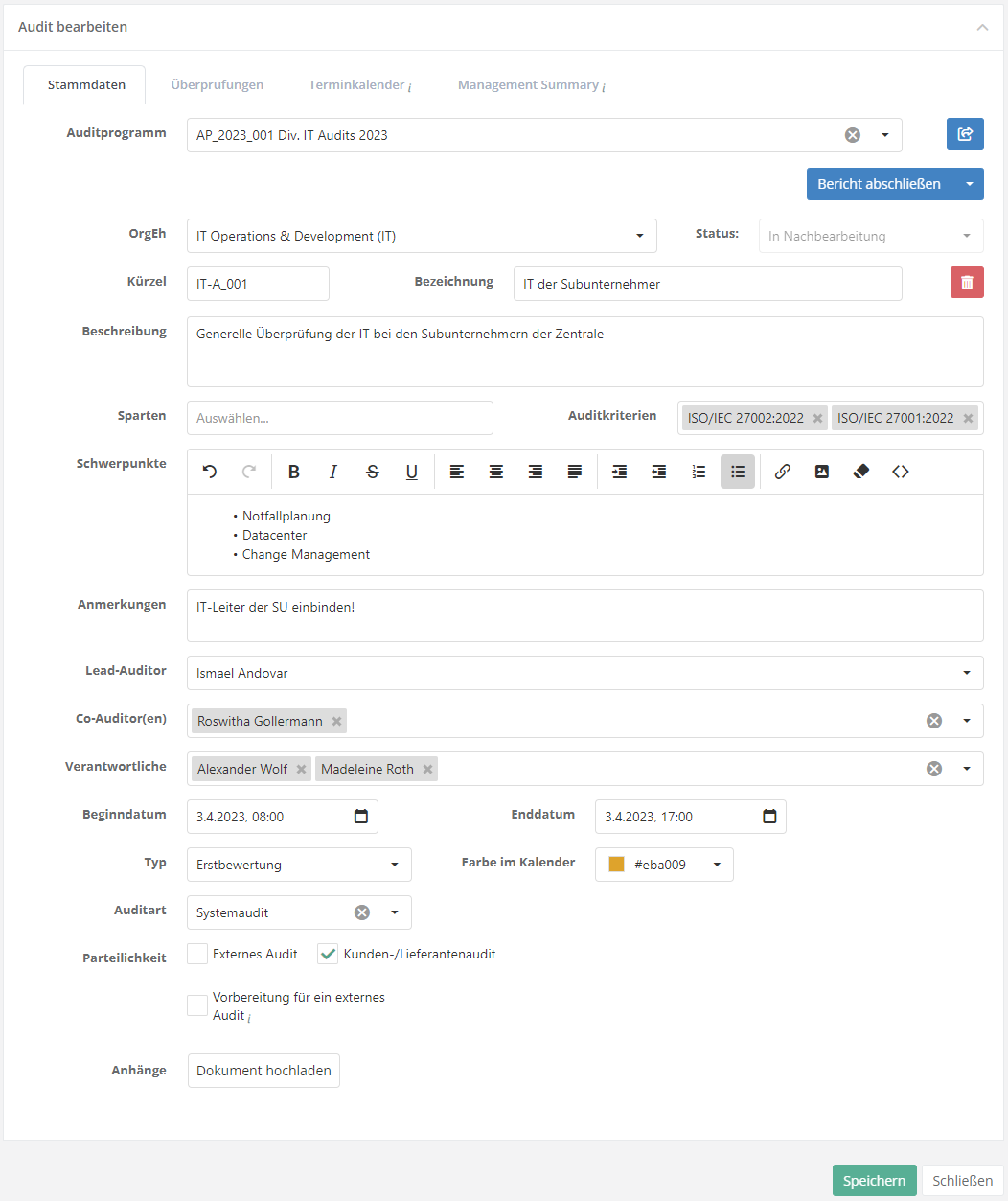
Audit status and workflow
This graphic describes how the workflow button affects the status of the audit:
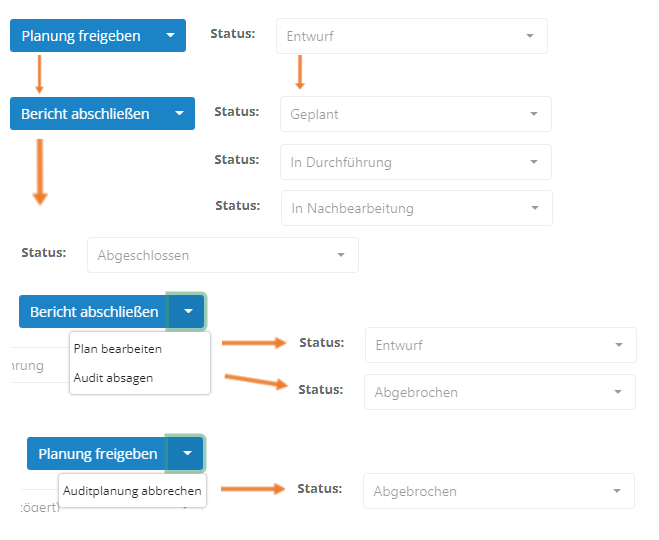
After an audit is created, it is in the "Draft" status. This status is additionally marked as "delayed" if the current date is later than the start date of the audit.
Only when the audit is released by the workflow button with the option "Release planning", it changes to the next status. The next status is either "Planned", "In progress" or "In rework". This status depends on the date of the audit and is changed automatically:
- Planned: The audit is released and the current date is earlier than the audit start date.
- In progress: Audit is released and the current date is between the audit start date and audit end date.
- In rework: The audit is released and the current date later than the audit end date.
During this status, the workflow button shows the option "Complete report". Clicking this closes the audit. The audit can also be closed automatically, as after the last open review is completed, the auditor will be asked if the audit should be closed.
Additionally, the workflow button can be expanded to return the audit to draft status or cancel it in general.
- Edit plan: Audit changes back into "Draft" state.
- Cancel audit planning/Cancel audit: Sets the audit to the state canceled.
Measures & controls
This overview shows all measures and controls that are linked with the audit, e.g., via the gaps identified in an analysis.
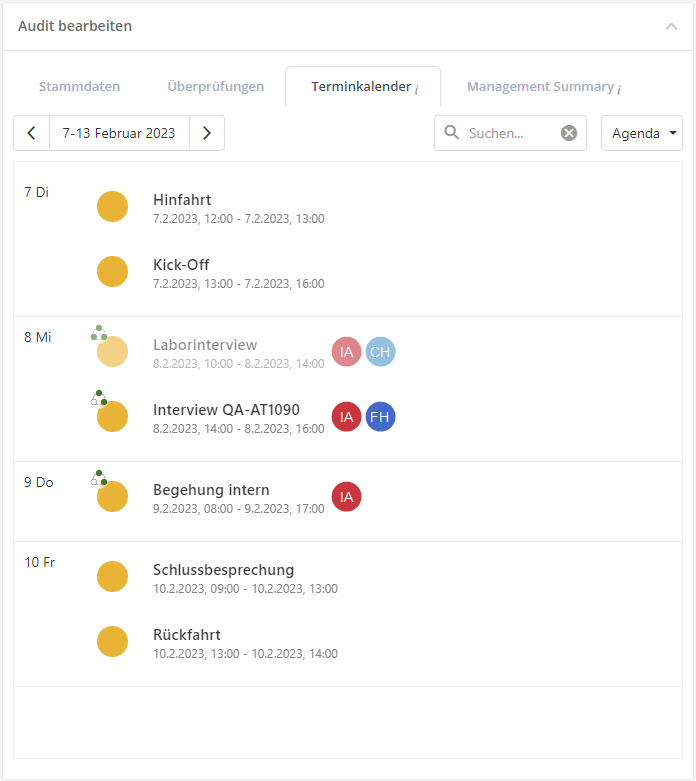
Appointment calendar
In the calendar, audit dates such as the start of an audit can be viewed or other dates that occur in the course of an audit, such as breaks or kick-off meetings, can be recorded.
The calendar within the audit shows the first appointment in the audit when opened. If there are no appointment entries within the audit yet, the start date of the audit is displayed.
The reviews and other appointments are displayed in the color that is stored in the audit.
In the calendar, the displayed period can be set in the upper left corner. With the dropdown on the top right you can switch between month, week, day and agenda display.
In the Agenda tab, you can find all the dates of the audit of the selected week.
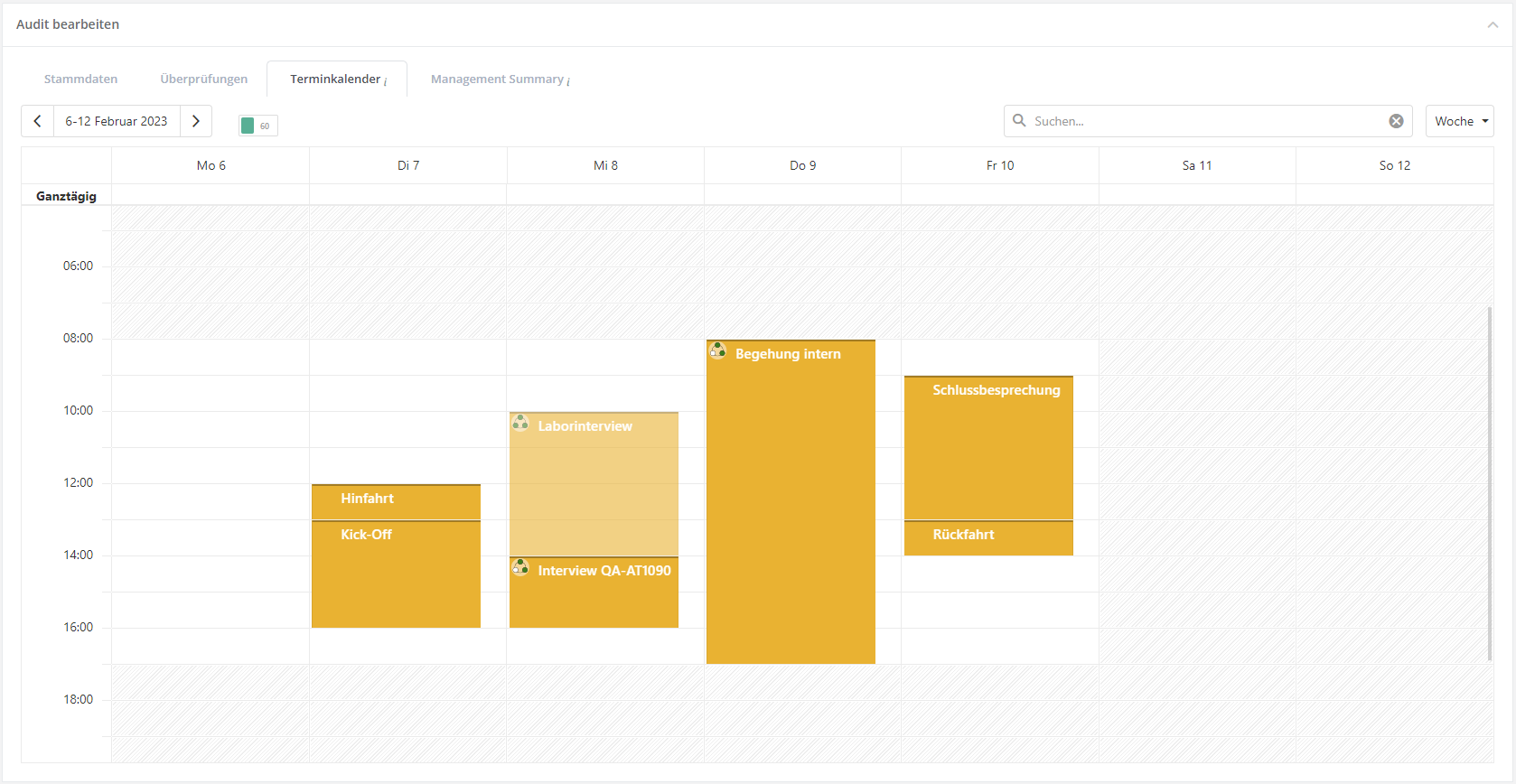
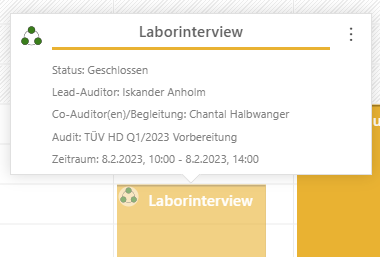
By simply clicking on a review, information about the review is displayed. By clicking on the edit button (pencil within the three dots on the top right), the respective review opens.
In the appointment schedule, appointments/reviews can also be created as described in Create appointment. However, this is only possible as long as the audit has not been closed.
Management Summary
A summary can be created for an audit to highlight the pros and cons of the audit. This summary can be used for various reports, such as the audit plan report.
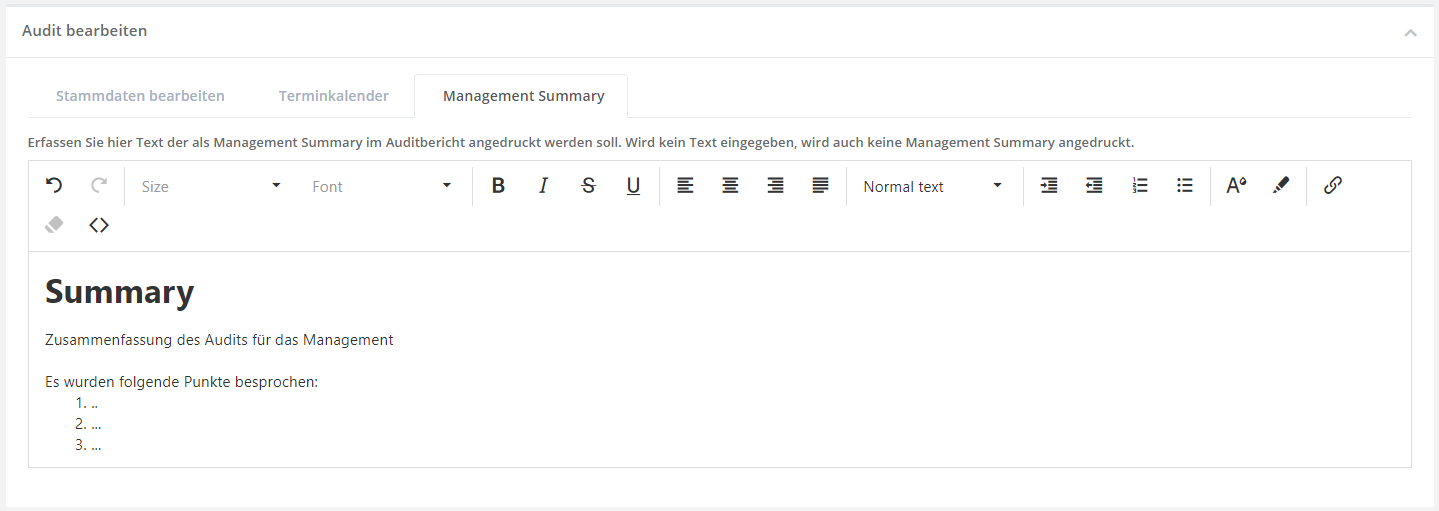
Audit programs
In the mask "Audit management → Audit planning → Audit calender | Audits | Audit Programs" all audit programs that exist in the currently selected management system are listed.

Create/edit/delete audit program
To create an audit program see create audit program.
If you want to delete or edit an audit program, e.g. because you want to add an audit, double-click on the desired program in the "Audit programs" overview.
To schedule or assign audits see Assigned audits
If you delete an audit program, the assigned audits are not deleted. They still exist and can be assigned to other audit programs.
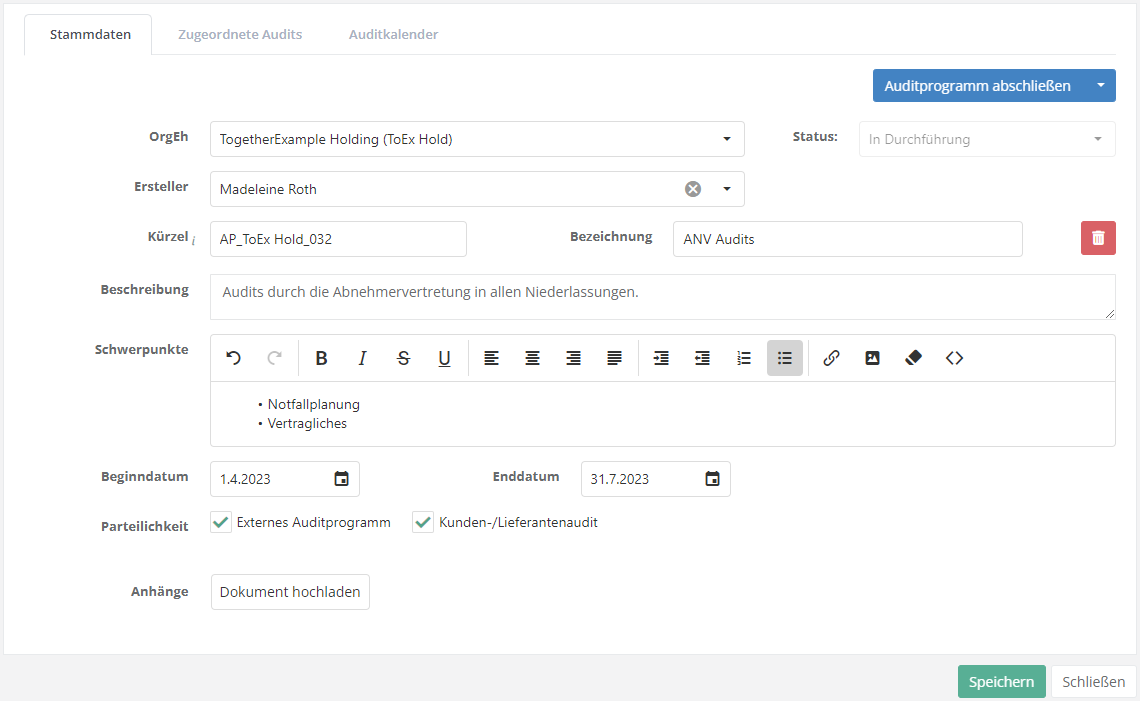
Status and workflow of audit programs
This graphic describes how the Workflow button affects the status of the audit program:
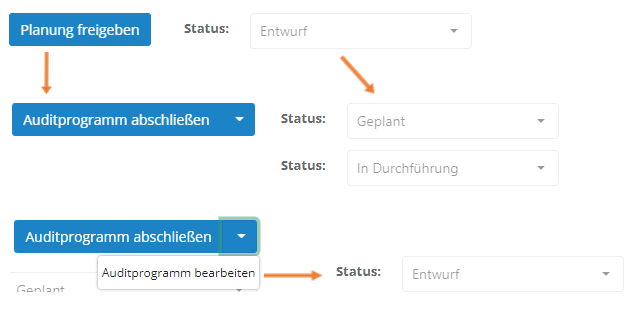
After an audit program is created, it is in "Draft" status.
Only when the audit program is released by the workflow button with the option "Release planning", it changes to the next status. The next status is either "Planned" or "In progress". This status depends on the date of the audit and is changed automatically:
- Planned: The audit program is released and the current date is earlier than the audit start date.
- In progress: The audit program is released and the current date is between the audit start date and audit end date.
In this status, the workflow button shows the option "Complete audit program". Clicking this closes the audit program. The audit program can also be closed automatically, since after the last open audit is completed, the auditor is asked whether the audit program should be closed.
In addition, the workflow button can be expanded to return the audit program into the "Draft" status.
Audit calendar
In the calendar, the dates of the audits of the audit program can be viewed. In the "Month" view, all audits that start, end or run in this month are displayed. In the "Agenda" view, it is possible to view what is planned for the week on a weekly basis. The view can be changed using the dropdown at the top right of the search field.
The calendar within the audit program shows the first appointment in the audit program when opened. If there are no appointment entries within the audit program yet, the start date of the audit program is displayed.
The radio buttons at the top left can be used to switch whether audits or reviews of audits are to be displayed.
Caution: Audits that do not have a start or end date are not displayed. Instead, information is provided about which audits are not displayed.
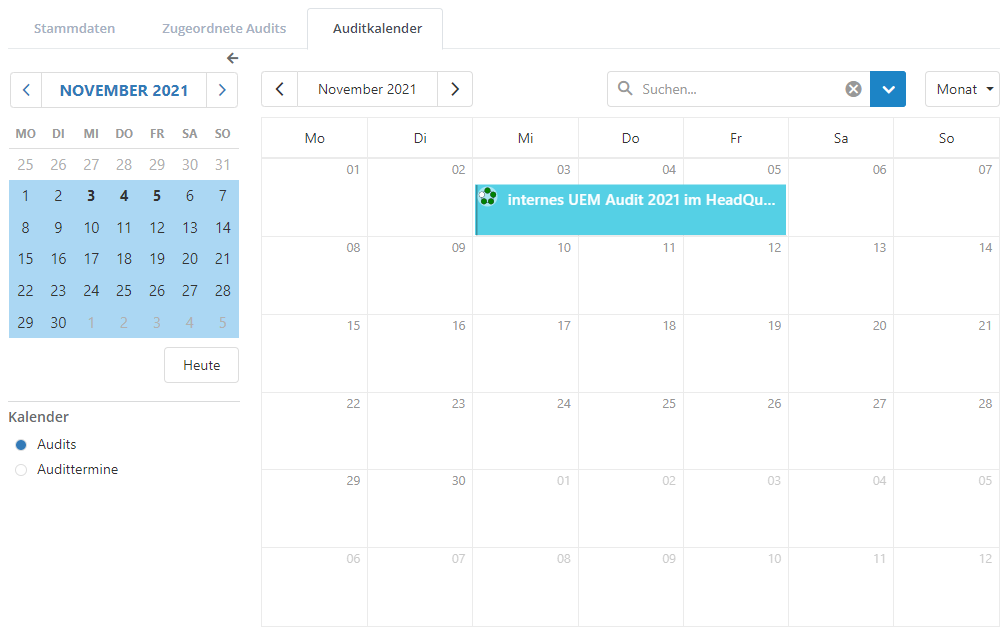

By simply clicking on an audit/review, additional information will be displayed. By clicking on the edit button (pencil within the three dots on the top right), the respective audit/review opens.
You can also carry out general/detailed planning (planning of blockers and conversion of blockiers into audits) in this calendar.
Furthermore, as described in Create appointment, appointments/reviews can also be created.
However, appointments can only be created as long as the audit program is not closed.
=Audit planner

Out of the audit program, the audit, and the corresponding overviews, it's possible to navigate to a planning view at the click of a button that offers these possibilities:
- edit master data (name, start and end date; for audits and assessments also the OU and the lead auditor)
- add audits to an audit program or remove them
- add assessments to an audit or remove them
- navigate to the audit program, an audit, or an assessment with one click
- add topics from knowledge bases and/or topic collections with drag & drop (find more on topic collections here)
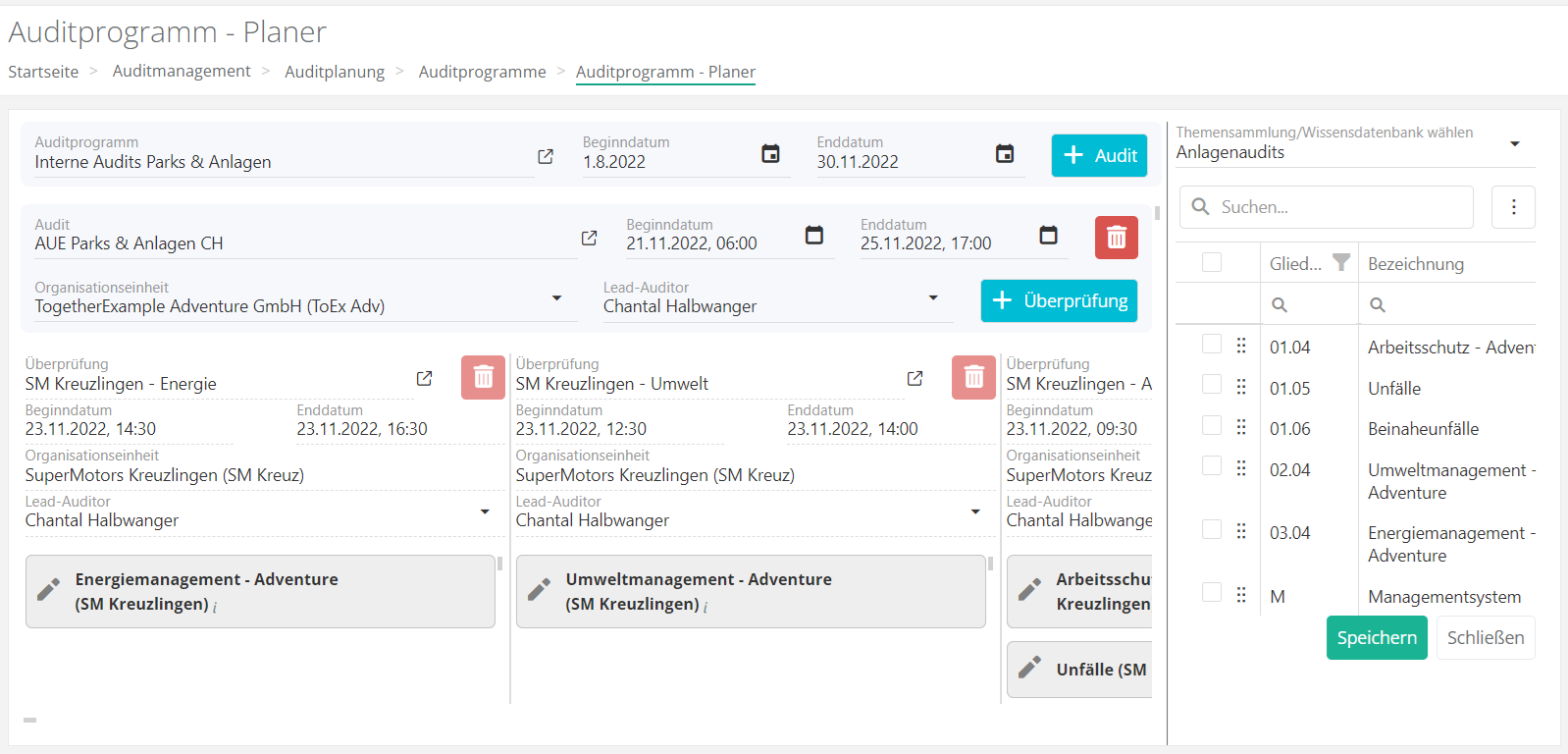
Vertical scrolling moves you from one audit to another within the audit program.
Horizontal scrolling moves you from one assessment to another within an audit.
New elements (audits and assessments) can be added with the various "plus" buttons. The "trash can" buttons serve to delete elements (audits and assessments) that haven't been closed yet. The "link" buttons take users to the respective elements.
Planner - audit program
Opening the planner from an audit program or from the overview of audit programs, takes you to an interface where you can access all audits of the program. You can edit or delete these, or create further audits. Within the audit, reviews can be created, edited, or deleted. Closed reviews, audits, and audit programs, however, are not editable.
Planner - audit
Opening the planner from an audit or from the overview of audits, takes you to an interface where you can also see the audit program. However, it only includes the selected audit, within which you are positioned in order to work there.
From the audit planner you can navigate to the audit program planner.
Adding review objects to reviews
In the audit planner you can select topic collections and knowledge bases, and receive a list of all topics contained therein. These can be added to reviews via drag & drop. When adding them, the list view shows how many times a topic has been added to reviews of the shown audits.
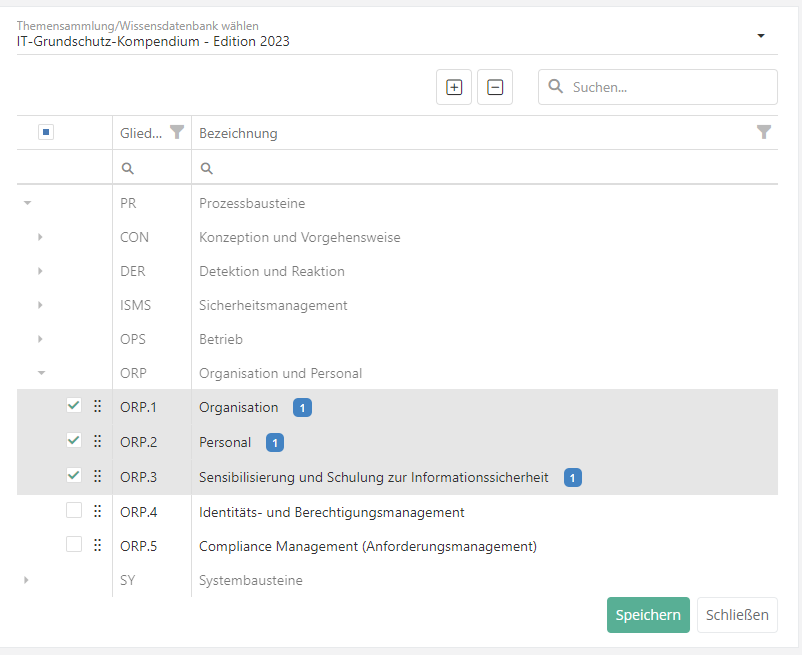
This makes it possible to edit all reviews of all audits of an audit program in one single view and to either split up larger topic collections among them or to assign smaller topic collections to one, more or all reviews. Topic collections and knowledge bases can be mixed when doing this.
=Revaluation via the audit planner
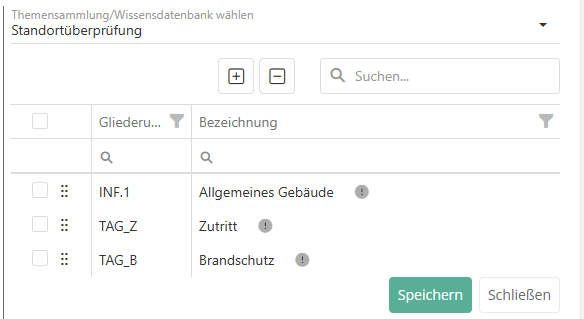
In the audit planner, an exclamation point shows if there is already a closed review for a topic from a knowledge base or a topic collection.
It is possible to create a revaluation instead of a further first-time evaluation for this topic. Just like in the review assistant under revaluation of existing review objects, you have the option to choose whether you would like to take over all/none/positive answers and whether you would like to pre-fill in a justification for all answers.

In the review itself, these topic/review objects have an "exclamation point" button which opens the dialog and allows the options to be edited.
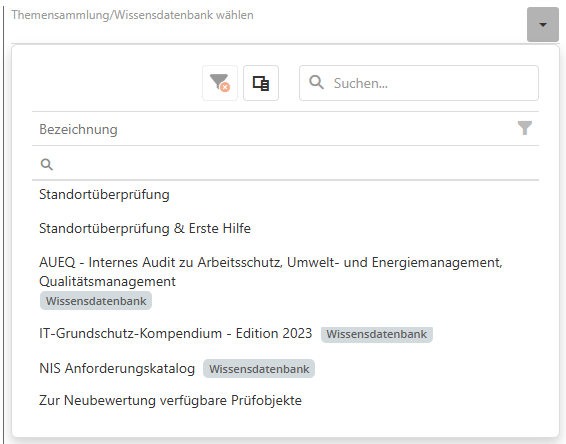
A further option the audit planner offers is the collected revaluation of different review objects, which can be viewed all together within the list item "Objects of review available for reassessment". From this overview you can then select all review objects you would like to revaluate. Here, too, you have the option to choose whether you would like to take over all/none/positive answers and whether you would like to pre-fill in a justification for all answers.